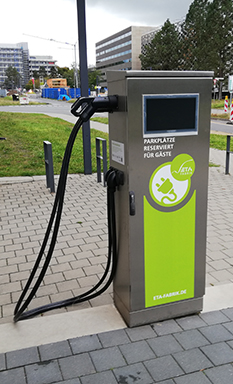
The charging station is energetically connected to the factory and thus provides electrical flexibility potential, which can be used in different applications within the production processes. Both single-phase and three-phase charging can be realized. The charging station meets the safety requirements for charging stations in public areas and is equipped with additional extensive measurement and monitoring hardware. The control of the charging station and the implementation of different charging strategies is realized by a PLC in the charging station. This is connected on the one hand to the electromobility controllers for communication with the loading vehicles and on the other hand to the central factory control system. The communication between driver and charging station is realized by a touch display in the charging station. A stainless steel solution was chosen for the housing for outdoor installation, which meets all protection requirements and fits into the design of the factory.
The PLC takes over communication tasks in addition to strategy calculation and control of the loading processes. The OPC UA standard prevailing in the factory is used here. On the software side, in addition to communication, the PLC of the charging station is used to implement the control system that connects and controls the various components of the charging station (charging controller, fuses, measuring devices, locking actuators, etc.). This also includes a user-friendly user interface on the touch display of the charging station.
At all three charging points, delayed starting, interruption and resumption of charging processes is possible without manual operation. In addition, during a charging process, the charging power can be continuously adjusted by adjusting the charging current. With the charging infrastructure and the functions mentioned above, different strategies can be implemented and tested in real operation. Here, individual solutions are conceivable that exclusively concern the charging infrastructure, but above all also integrated strategies that interact, for example, with the hybrid storage system or other energy components or processes of the factory.

